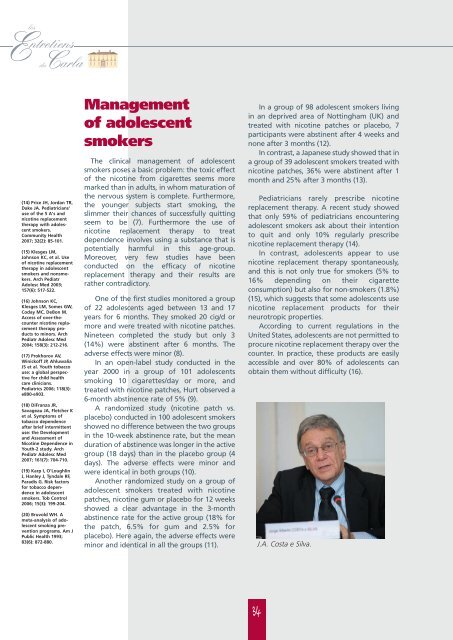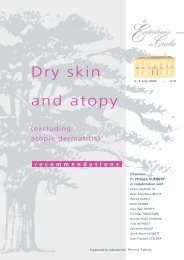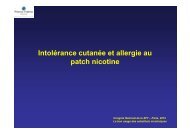Nicotine replacement therapy … - Carlos A ... - Entretiens du Carla
Nicotine replacement therapy … - Carlos A ... - Entretiens du Carla
Nicotine replacement therapy … - Carlos A ... - Entretiens du Carla
You also want an ePaper? Increase the reach of your titles
YUMPU automatically turns print PDFs into web optimized ePapers that Google loves.
(14) Price JH, Jordan TR,<br />
Dake JA. Pediatricians'<br />
use of the 5 A's and<br />
nicotine <strong>replacement</strong><br />
<strong>therapy</strong> with adolescent<br />
smokers.<br />
Community Health<br />
2007; 32(2): 85-101.<br />
(15) Klesges LM,<br />
Johnson KC, et al. Use<br />
of nicotine <strong>replacement</strong><br />
<strong>therapy</strong> in adolescent<br />
smokers and nonsmokers.<br />
Arch Pediatr<br />
Adolesc Med 2003;<br />
157(6): 517-522.<br />
(16) Johnson KC,<br />
Klesges LM, Somes GW,<br />
Coday MC, DeBon M.<br />
Access of over-thecounter<br />
nicotine <strong>replacement</strong><br />
<strong>therapy</strong> pro<strong>du</strong>cts<br />
to minors. Arch<br />
Pediatr Adolesc Med<br />
2004; 158(3): 212-216.<br />
(17) Prokhorov AV,<br />
Winickoff JP, Ahluwalia<br />
JS et al. Youth tobacco<br />
use: a global perspective<br />
for child health<br />
care clinicians.<br />
Pediatrics 2006; 118(3):<br />
e890-e903.<br />
(18) DiFranza JR,<br />
Savageau JA, Fletcher K<br />
et al. Symptoms of<br />
tobacco dependence<br />
after brief intermittent<br />
use: the Development<br />
and Assessment of<br />
<strong>Nicotine</strong> Dependence in<br />
Youth-2 study. Arch<br />
Pediatr Adolesc Med<br />
2007; 161(7): 704-710.<br />
(19) Karp I, O'Loughlin<br />
J, Hanley J, Tyndale RF,<br />
Paradis G. Risk factors<br />
for tobacco dependence<br />
in adolescent<br />
smokers. Tob Control<br />
2006; 15(3): 199-204.<br />
(20) Bruvold WH. A<br />
meta-analysis of adolescent<br />
smoking prevention<br />
programs. Am J<br />
Public Health 1993;<br />
83(6): 872-880.<br />
Management<br />
of adolescent<br />
smokers<br />
The clinical management of adolescent<br />
smokers poses a basic problem: the toxic effect<br />
of the nicotine from cigarettes seems more<br />
marked than in a<strong>du</strong>lts, in whom maturation of<br />
the nervous system is complete. Furthermore,<br />
the younger subjects start smoking, the<br />
slimmer their chances of successfully quitting<br />
seem to be (7). Furthermore the use of<br />
nicotine <strong>replacement</strong> <strong>therapy</strong> to treat<br />
dependence involves using a substance that is<br />
potentially harmful in this age-group.<br />
Moreover, very few studies have been<br />
con<strong>du</strong>cted on the efficacy of nicotine<br />
<strong>replacement</strong> <strong>therapy</strong> and their results are<br />
rather contradictory.<br />
One of the first studies monitored a group<br />
of 22 adolescents aged between 13 and 17<br />
years for 6 months. They smoked 20 cig/d or<br />
more and were treated with nicotine patches.<br />
Nineteen completed the study but only 3<br />
(14%) were abstinent after 6 months. The<br />
adverse effects were minor (8).<br />
In an open-label study con<strong>du</strong>cted in the<br />
year 2000 in a group of 101 adolescents<br />
smoking 10 cigarettes/day or more, and<br />
treated with nicotine patches, Hurt observed a<br />
6-month abstinence rate of 5% (9).<br />
A randomized study (nicotine patch vs.<br />
placebo) con<strong>du</strong>cted in 100 adolescent smokers<br />
showed no difference between the two groups<br />
in the 10-week abstinence rate, but the mean<br />
<strong>du</strong>ration of abstinence was longer in the active<br />
group (18 days) than in the placebo group (4<br />
days). The adverse effects were minor and<br />
were identical in both groups (10).<br />
Another randomized study on a group of<br />
adolescent smokers treated with nicotine<br />
patches, nicotine gum or placebo for 12 weeks<br />
showed a clear advantage in the 3-month<br />
abstinence rate for the active group (18% for<br />
the patch, 6.5% for gum and 2.5% for<br />
placebo). Here again, the adverse effects were<br />
minor and identical in all the groups (11).<br />
In a group of 98 adolescent smokers living<br />
in an deprived area of Nottingham (UK) and<br />
treated with nicotine patches or placebo, 7<br />
participants were abstinent after 4 weeks and<br />
none after 3 months (12).<br />
In contrast, a Japanese study showed that in<br />
a group of 39 adolescent smokers treated with<br />
nicotine patches, 36% were abstinent after 1<br />
month and 25% after 3 months (13).<br />
Pediatricians rarely prescribe nicotine<br />
<strong>replacement</strong> <strong>therapy</strong>. A recent study showed<br />
that only 59% of pediatricians encountering<br />
adolescent smokers ask about their intention<br />
to quit and only 10% regularly prescribe<br />
nicotine <strong>replacement</strong> <strong>therapy</strong> (14).<br />
In contrast, adolescents appear to use<br />
nicotine <strong>replacement</strong> <strong>therapy</strong> spontaneously,<br />
and this is not only true for smokers (5% to<br />
16% depending on their cigarette<br />
consumption) but also for non-smokers (1.8%)<br />
(15), which suggests that some adolescents use<br />
nicotine <strong>replacement</strong> pro<strong>du</strong>cts for their<br />
neurotropic properties.<br />
According to current regulations in the<br />
United States, adolescents are not permitted to<br />
procure nicotine <strong>replacement</strong> <strong>therapy</strong> over the<br />
counter. In practice, these pro<strong>du</strong>cts are easily<br />
accessible and over 80% of adolescents can<br />
obtain them without difficulty (16).<br />
J.A. Costa e Silva.<br />
34






